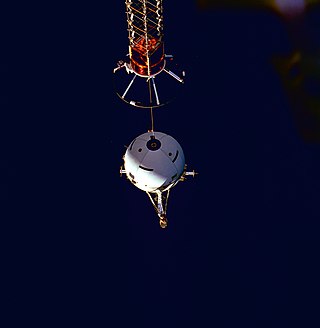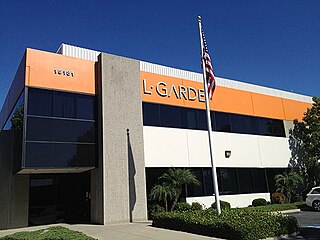External links
- The Space Show: Interview with Hoyt retrieved 4th Jan 2010
Robert P. Hoyt | |
|---|---|
| Born | September 15, 1968 |
| Known for | Developing the SpiderFab |
| Scientific career | |
| Fields | Physics and engineering |
Robert P. Hoyt (born September 15, 1968) is a physicist and engineer who is known for his work developing the SpiderFab [1] [2] architecture for in-space additive manufacture of spacecraft as well as for his invention of the Hoytether. [3] [4] He also originated the MXER Tether concept, which combines momentum-exchange techniques with electrodynamic reboost propulsion to enable a bolo tether system to serve as a fully reusable in-space upper stage for boosting many payloads from LEO to GEO or lunar trajectories. He also has done work and collaborated with the late Robert L. Forward on electrodynamic space tethers for use for deorbiting space junk and interplanetary transport. [5] He was one of the authors of a paper on using tethers for cis-lunar transportation. [6] The Cooper Hewitt Smithsonian Design Museum included a Hoytether designed and fabricated by Hoyt in an exhibition on high-tech textiles. [7]
In addition to his work on space tethers, Hoyt has pioneered methods for using additive manufacturing to create structures and components for spacecraft, both on the ground and in orbit, and has worked to develop self-fabricating satellites under funding from DARPA and NASA. [8] Hoyt also invented the Structureless Antenna technology, which uses electrostatic forces to deploy ultra-lightweight large-aperture antenna reflectors, enabling small spacecraft to deploy and use large, high-gain antennas. Other projects he has been involved with are an invention to drain the Van Allen radiation belts, development of robotic arms for small spacecraft, and development of tether-based methods to enable tiny nanosatellites to capture and de-spin asteroids and space debris objects.
Hoyt is the CEO and Chief Scientist of Tethers Unlimited, Inc.
Hoyt also co-founded ScienceOps in 2007, a company that develops custom scientific algorithms and software for a wide range of industries, including biotech, online advertising, and aerospace. ScienceOps was acquired by Acquisio in 2012.

Nuclear pulse propulsion or external pulsed plasma propulsion is a hypothetical method of spacecraft propulsion that uses nuclear explosions for thrust. It originated as Project Orion with support from DARPA, after a suggestion by Stanislaw Ulam in 1947. Newer designs using inertial confinement fusion have been the baseline for most later designs, including Project Daedalus and Project Longshot.

The Apollo Lunar Module, or simply Lunar Module, originally designated the Lunar Excursion Module (LEM), was the Lunar lander spacecraft that was flown between lunar orbit and the Moon's surface during the United States' Apollo program. It was the first crewed spacecraft to operate exclusively in the airless vacuum of space, and remains the only crewed vehicle to land anywhere beyond Earth.

The NASA Deep Space Network (DSN) is a worldwide network of American spacecraft communication ground segment facilities, located in the United States (California), Spain (Madrid), and Australia (Canberra), that supports NASA's interplanetary spacecraft missions. It also performs radio and radar astronomy observations for the exploration of the Solar System and the universe, and supports selected Earth-orbiting missions. DSN is part of the NASA Jet Propulsion Laboratory (JPL).

A skyhook is a proposed momentum exchange tether that aims to reduce the cost of placing payloads into low Earth orbit. A heavy orbiting station is connected to a cable which extends down towards the upper atmosphere. Payloads, which are much lighter than the station, are hooked to the end of the cable as it passes, and are then flung into orbit by rotation of the cable around the center of mass. The station can then be reboosted to its original altitude by electromagnetic propulsion, rocket propulsion, or by deorbiting another object with the same kinetic energy as transferred to the payload.
A momentum exchange tether is a kind of space tether that could theoretically be used as a launch system, or to change spacecraft orbits. Momentum exchange tethers create a controlled force on the end-masses of the system due to the pseudo-force known as centrifugal force. While the tether system rotates, the objects on either end of the tether will experience continuous acceleration; the magnitude of the acceleration depends on the length of the tether and the rotation rate. Momentum exchange occurs when an end body is released during the rotation. The transfer of momentum to the released object will cause the rotating tether to lose energy, and thus lose velocity and altitude. However, using electrodynamic tether thrusting, or ion propulsion the system can then re-boost itself with little or no expenditure of consumable reaction mass.

Electrodynamic tethers (EDTs) are long conducting wires, such as one deployed from a tether satellite, which can operate on electromagnetic principles as generators, by converting their kinetic energy to electrical energy, or as motors, converting electrical energy to kinetic energy. Electric potential is generated across a conductive tether by its motion through a planet's magnetic field.

In radio communications, an evolved antenna is an antenna designed fully or substantially by an automatic computer design program that uses an evolutionary algorithm that mimics Darwinian evolution. This procedure has been used in recent years to design a few antennas for mission-critical applications involving stringent, conflicting, or unusual design requirements, such as unusual radiation patterns, for which none of the many existing antenna types are adequate.

The NASA Institute for Advanced Concepts (NIAC) is a NASA program for development of far reaching, long term advanced concepts by "creating breakthroughs, radically better or entirely new aerospace concepts". The program operated under the name NASA Institute for Advanced Concepts from 1998 until 2007, and was reestablished in 2011 under the name NASA Innovative Advanced Concepts and continues to the present. The NIAC program funds work on revolutionary aeronautics and space concepts that can dramatically impact how NASA develops and conducts its missions.

Spacecraft electric propulsion is a type of spacecraft propulsion technique that uses electrostatic or electromagnetic fields to accelerate mass to high speed and thus generate thrust to modify the velocity of a spacecraft in orbit.
The Multi-Application Survivable Tether (MAST) experiment was an in-space investigation designed to use CubeSat spacecraft connected by tethers to better understand the survivability of tethers in space. It was launched as a secondary payload on a Dnepr rocket on 17 April 2007 into a 98°, 647 x 782 km orbit. The MAST payload incorporated three picosatellites, named "Ralph," "Ted," and "Gadget," which were intended to separate and deploy a 1 km (0.62 mi) tether. The experiment hardware was designed under a NASA Small Business Technology Transfer (STTR) collaboration between Tethers Unlimited, Inc. (TUI) and Stanford University, with TUI developing the tether, tether deployer, tether inspection subsystem, satellite avionics, and software, and Stanford students developing the satellite structures and assisting with the avionics design.
Jerome Pearson was an American engineer and space scientist best known for his work on space elevators, including a lunar space elevator. He was president of STAR, Inc., and has developed aircraft and spacecraft technology for the United States Air Force, DARPA, and NASA. He held several patents and was the author of nearly 100 publications in aircraft, spacecraft, electrodynamic tethers, SETI, and global climate control.

A number of space tethers have been deployed in space missions. Tether satellites can be used for various purposes including research into tether propulsion, tidal stabilisation and orbital plasma dynamics.

Space tethers are long cables which can be used for propulsion, momentum exchange, stabilization and attitude control, or maintaining the relative positions of the components of a large dispersed satellite/spacecraft sensor system. Depending on the mission objectives and altitude, spaceflight using this form of spacecraft propulsion is theorized to be significantly less expensive than spaceflight using rocket engines.

Project Morpheus was a NASA project that began in 2010 to develop a vertical takeoff and vertical landing (VTVL) test vehicle called the Morpheus Lander. It is intended to demonstrate a new nontoxic spacecraft propellant system and an autonomous landing and hazard detection technology. The prototype planetary lander is capable of autonomous flight, including vertical takeoff and landings. The vehicles are NASA-designed robotic landers that will be able to land and take off with 1,100 pounds(500 kg) of cargo on the Moon. The prospect is an engine that runs reliably on propellants that are not only cheaper and safer here on Earth, but could also be potentially manufactured on the Moon and Mars.

The Asteroid Redirect Mission (ARM), also known as the Asteroid Retrieval and Utilization (ARU) mission and the Asteroid Initiative, was a space mission proposed by NASA in 2013. The Asteroid Retrieval Robotic Mission (ARRM) spacecraft would rendezvous with a large near-Earth asteroid and use robotic arms with anchoring grippers to retrieve a 4-meter boulder from the asteroid.
Tethers Unlimited, Inc. (TUI) is an American private aerospace company headquartered near Seattle, Washington, which performs research and development of new products and technologies for space, sea, and air.

LGarde, also L'Garde or L·Garde, is an American aerospace and defense technology company founded in 1971 in Orange County, CA and is the primary contractor for the Sunjammer spacecraft, the world largest solar sail. The company was an early pioneer of thin-skinned, multi-task inflatable structures used in various military and space applications. At the height of the Cold War, L·Garde developed and manufactured inflatable targets and decoy systems for U.S. military defense, and countermeasure systems for the Strategic Defense Initiative. After the Cold-War, the company used the technologies and manufacturing techniques it had developed to land a contract to design and build the inflatable antenna experiment and other thin-film inflatable space structures using its unique application of rigidizable tube technology. The company's unusual name is an acronym formed by the initials of the founding partners: Bill Larkin, Gayle Bilyeu, Alan Hirasuna, Rich Walstrom, Don Davis. The "E" comes from the Latin term "et al" as a tip to other partners and original employees of the company.

Earth Escape Explorer (CU-E3) is a nanosatellite of the 6U CubeSat format that will demonstrate long-distance communications while in heliocentric orbit.

Bi-sat Observations of the Lunar Atmosphere above Swirls (BOLAS) is a spacecraft mission concept that would orbit the Moon at very low altitude in order to study the lunar surface. The concept, currently under study by NASA, involves two small identical CubeSat satellites connected vertically above the lunar surface by a 25 km long tether. The mission goal would be to understand the hydrogen cycle on the Moon, dust weathering, and the formation of lunar swirls.
The World Is Not Enough (WINE) is a US project developing a refuelable steam engine system for spacecraft propulsion. WINE developed a method of extracting volatiles from ice, ice-rich regolith, and hydrated soils and uses it as steam propulsion which allows the spacecraft to refuel multiple times and have an extraordinary long service lifetime. This would allow a single spacecraft to visit multiple asteroids, comets or several landing locations at an icy world such as the Moon, Mars, Pluto, Enceladus, Ganymede, Europa, etc.